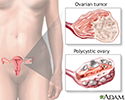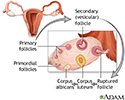Ovarian overproduction of androgens
Ovarian overproduction of androgens is a condition in which the ovaries make too much testosterone . This leads to the development of male characteristics in a woman. Androgens from other parts of the body can also cause male characteristics to develop in women.
Testosterone
A testosterone test measures the amount of the male hormone, testosterone, in the blood. Both men and women produce this hormone. The test described...
Causes
In healthy women, the ovaries and adrenal glands produce about 40% to 50% of the body's testosterone. Tumors of the ovaries and polycystic ovary syndrome (PCOS) can both cause too much androgen production.
Cushing disease is a problem with the pituitary gland that leads to excess amounts of corticosteroids. Corticosteroids cause masculine body changes in women. Tumors in the adrenal glands can also cause too much production of androgens and can lead to male body characteristics in women.
Symptoms
High levels of androgens in a female can cause:
- Acne
- Changes in female body shape
- Decrease in breast size
- Increase in body hair in a male pattern, such as on the face, chin, and abdomen
- Lack of menstrual periods (amenorrhea)
- Oily skin
These changes may also occur:
- Increase in the size of the clitoris
- Deepening of the voice
- Increase in muscle mass
- Thinning hair and hair loss at the front of the scalp on both sides of the head
Exams and Tests
Your health care provider will perform a physical exam. Any blood and imaging tests ordered will depend on your symptoms, but may include:
- 17-hydroxyprogesterone test
- ACTH test
- CT scan
- DHEA blood test
- Glucose test
- Insulin test
- Pelvic ultrasound
- Prolactin test (if periods come less often or not at all)
- Testosterone test
- Total cholesterol test
- TSH test (if there is hair loss)
Treatment
Treatment depends on the problem that is causing the increased androgen production. Medicines can be given to decrease hair production in women with excess body hair, or to regulate menstrual cycles. In some cases, surgery may be needed to remove an ovarian or adrenal tumor.
Outlook (Prognosis)
Treatment success depends on the cause of excess androgen production. If the condition is caused by an ovarian tumor, surgery to remove the tumor may correct the problem. Most ovarian tumors are not cancerous (benign), and will not come back after they have been removed.
In polycystic ovary syndrome, the following measures can reduce symptoms caused by high androgen levels:
- Careful monitoring
- Weight loss
- Dietary changes
- Medicines
- Regular vigorous exercise
Possible Complications
Infertility and complications during pregnancy may occur.
Women with polycystic ovary syndrome may be at increased risk for:
- Diabetes
- High blood pressure
- High cholesterol
- Obesity
- Uterine cancer
Prevention
There is no known prevention. Maintaining a normal weight through a healthy diet and regular exercise can reduce your chances of any long-term complications.
References
Bulun SE. The physiology and pathology of the female reproductive axis. In: Melmed S, Polonsky KS, Larsen PR, Kronenberg HM, eds. Williams Textbook of Endocrinology . 13th ed. Philadelphia, PA: Elsevier Saunders; 2016:chap 17.
Gibson M, Huddleston HG. Polycystic ovary syndrome and hirsutism. In: Kliegman RM, Stanton BF, St. Geme JW, Schor NF, eds. Nelson Textbook of Pediatrics . 20th ed. Philadelphia, PA: Elsevier; 2016:chap 552.
Lobo RA. Hyperandrogenism: physiology, etiology, differential diagnosis, management. In: Lentz GM, Lobo RA, Gershenson DM, Katz VL, eds. Comprehensive Gynecology . 6th ed. Philadelphia, PA: Elsevier; 2012:chap 40.
Rosenfield RL, Barnes RB, Ehrmann DA. Hyperandrogenism, hirsutism, and polycystic ovary syndrome. In: Jameson JL, De Groot LJ, de Kretser DM, et al, eds. Endocrinology: Adult and Pediatric . 7th ed. Philadelphia, PA: Elsevier Saunders; 2016:chap 133.
-
Overproductive ovaries - illustration
If the ovaries produce too much androgen (hormones such as testosterone), a woman may develop male characteristics. This ovarian imbalance can be caused by tumors in the ovaries or adrenal glands, or by polycystic ovarian syndrome. Hyperandrogenism may include growth of excess body and facial hair, acne, amenorrhea (loss of menstrual periods), and changes in body shape. Virilization can occur with ovarian and adrenal tumors and includes deepening of the voice, male pattern balding, and increased muscle mass.
Overproductive ovaries
illustration
-
Follicle development - illustration
Normal egg release from the ovaries, shown in stages of development.
Follicle development
illustration
-
Overproductive ovaries - illustration
If the ovaries produce too much androgen (hormones such as testosterone), a woman may develop male characteristics. This ovarian imbalance can be caused by tumors in the ovaries or adrenal glands, or by polycystic ovarian syndrome. Hyperandrogenism may include growth of excess body and facial hair, acne, amenorrhea (loss of menstrual periods), and changes in body shape. Virilization can occur with ovarian and adrenal tumors and includes deepening of the voice, male pattern balding, and increased muscle mass.
Overproductive ovaries
illustration
-
Follicle development - illustration
Normal egg release from the ovaries, shown in stages of development.
Follicle development
illustration
Review Date: 5/16/2016
Reviewed By: Irina Burd, MD, PhD, Associate Professor of Gynecology and Obstetrics at Johns Hopkins University School of Medicine, Baltimore, MD. Review provided by VeriMed Healthcare Network. Also reviewed by David Zieve, MD, MHA, Isla Ogilvie, PhD, and the A.D.A.M. Editorial team.


